-
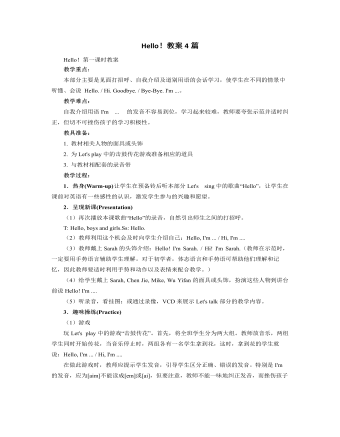
人教版新课标PEP小学英语三年级上册Hello!教案4篇
(3)通过游戏Simon says 来练习以show, open, close, put, carry 所引导的祈使句。教师发指令学生做动作。但只有听到老师带有Simon says的指令时,才能做出相应的动作,否则就是失败。失败的同学退出游戏。(4)听Let's chant的录音,学生边听边做,逐渐过渡成边听边说边做,最后独立说做,并进行比赛。4. 课堂评价(Assessment)做活动手册本单元第5部分练习。学生根据录音,圈出所听到的文具。具体方法和步骤参考如下:(1)学生看图,用英语说出图中每样文具物品。(2)教师讲解题目的意思并指导做的方法。(3)学生听录音做练习。(4)再放录音,在教师的指导下让学生一句一句地跟读并互相核对答案,并说出所圈的文具,再通过给花朵涂色进行自我评价。5. 扩展性活动(Extensive activities)选词游戏。将学生分为六组,每组各派一个选手,教师说单词,选手快步跑到讲台前,找到所说单词,并举起大声读出,正确为胜。
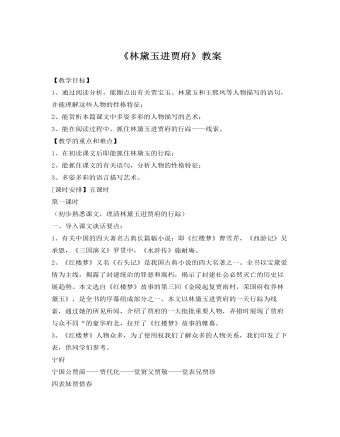
人教版高中语文《林黛玉进贾府》教案
第一课时(初步熟悉课文,理清林黛玉进贾府的行踪)一、导入课文谈话要点:1、有关中国的四大著名古典长篇幅小说:即《红楼梦》曹雪芹,《西游记》吴承恩,《三国演义》罗贯中,《水浒传》施耐庵。2、《红楼梦》又名《石头记》是我国古典小说的四大名著之一。全书以宝黛爱情为主线,揭露了封建统治的罪恶和腐朽,揭示了封建社会必然灭亡的历史以展趋势。本文选自《红楼梦》故事的第三回《金陵起复贾雨村,荣国府收养林黛玉》,是全书的序幕组成部分之一。本文以林黛玉进贾府的一天行踪为线索,通过她的所见所闻,介绍了贾府的一大批批重要人物,弄错时展现了贾府与众不同“的豪华府北,拉开了《红楼梦》故事的帷幕。3、《红楼梦》人物众多,为了使用权我们了解众多的人物关系,我们印发了下表,供同学们参考。
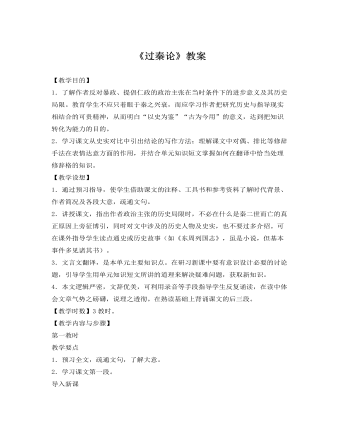
人教版高中语文《过秦论》教案
【教学目的】1.了解作者反对暴政、提倡仁政的政治主张在当时条件下的进步意义及其历史局限。教育学生不应只着眼于秦之兴衰,而应学习作者把研究历史与指导现实相结合的可贵精神,从而明白“以史为鉴”“古为今用”的意义,达到把知识转化为能力的目的。2.学习课文从史实对比中引出结论的写作方法;理解课文中对偶、排比等修辞手法在表情达意方面的作用,并结合单元知识短文掌握如何在翻译中恰当处理修辞格的知识。【教学设想】1.通过预习指导,使学生借助课文的注释、工具书和参考资料了解时代背景、作者简况及各段大意,疏通文句。2.讲授课文,指出作者政治主张的历史局限时,不必在什么是秦二世而亡的真正原因上旁征博引,同时对文中涉及的历史人物及史实,也不要过多介绍。可在课外指导学生读点通史或历史故事(如《东周列国志》,虽是小说,但基本事件多见诸其书)。
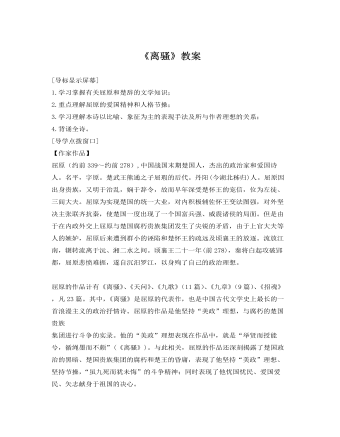
人教版高中语文《离骚》教案
2.亦余心之所善兮。虽九死其犹未悔评析:这一句表明屈原志向不改,坚贞不屈。真可说是一条铁骨铮铮的汉子。屈原最不能容忍的是那群无耻小人对他的恶毒诬蔑,一会说他穿着奇装异服,一会又说他面容姣好,肯定是个善淫之辈。这群人追名逐利,篡改法令,歪曲是非,混淆黑白,竞相谄媚,把朝廷弄得乌烟瘴气。屈原下决心绝对不和他们合流,他自比不合群的鸷鸟,孤傲、矫健,“自前世而固然”,他不想改变,也无法改变,这就像方圆不能周,异道不相安一样。在这里,屈原清楚地预感到了自己的结局,但他并不后悔自己的选择。句中“虽九死其犹未悔”和同出自于《离骚》的“路曼曼其修远兮,吾将上下而求索”诗句是后人引以自勉和共勉最多的句子。运用:(翻译)只要是我心中所向往喜欢的,即使死去九次也不会后悔。3.民生各有所乐兮,余独好修以为常。虽体解吾犹未变兮,岂余心之可惩。

人教版高中语文《沁园春》教案
【重点、难点及解决办法】1.以乐景写哀,景中寓情,情中显志。从词中可以感受到词人的心情是惆怅的,写的又是寒秋景物,却毫无过去一般旧诗词里的那种肃杀、感伤的“悲秋”情调,词人笔下的秋景是活泼、美好的。原因在于越写山河的壮丽,就越使人感到人民不能主宰大地的可悲,越感到革命的必要。词人正是在这不一致中突出了强烈的革命精神。当然,这里面也含有热爱祖国壮丽河山的感情。2.对比手法的运用。词中含有多种对比,使描绘的形象鲜明,如“万山红遍”与“漫江碧透”主要是颜色的对比;“鹰击长空”与“鱼翔浅底”、“指点江山”与“激扬文字”主要是动作的对比;“同学少年”与“万户侯”是明比;“万类霜天竞自由”与人民的被压迫(未在词中点明)是暗含的对比。
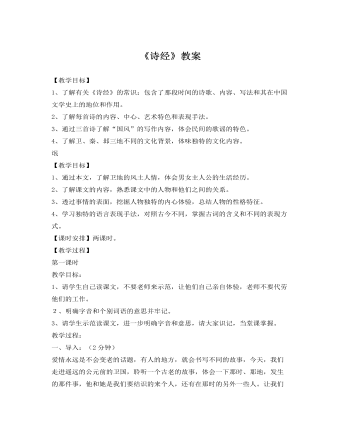
人教版高中语文《诗经》教案
《诗经》的重章叠唱及表现手法《诗经》善于运用重章叠唱来表达思想感情,即重复的几章间,意义和字面都只有少量改变,造成一唱三叹的效果。增强了诗歌的音乐性和节奏感,更充分的抒发了情怀。《诗经》里大量运用了赋、比、兴的表现手法,加强了作品的形象性,获得了良好的艺术效果。所谓“赋”是“敷陈其事而直言之”。这包括一般陈述和铺排陈述两种情况。“比”是“以彼物比此物”,也就是比喻之意。而“兴”则是《诗经》乃至中国诗歌中比较独特的手法。“兴”字的本义是“起”。《诗经》中的“兴”是“先言他物以引起所咏之辞”,也就是借助其他事物为所咏之内容作铺垫。它往往用于一首诗或一章诗的开头。大约最原始的“兴”,只是一种发端,同下文并无意义上的关系,表现出思绪无端地飘移联想。
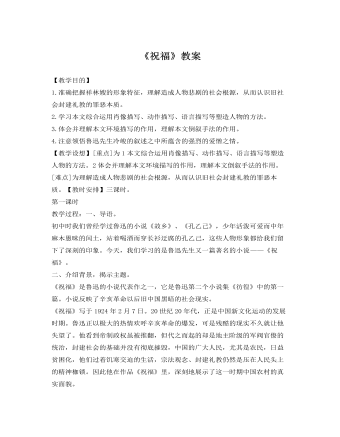
人教版高中语文《祝福》教案
C.人们的态度:“大家仍然叫她祥林嫂”,称呼依旧。这一淡淡的似乎不经意的过渡语,在具体语境中却隐含着深刻的蕴涵,反映出鲁四一家对祥林嫂的第二次婚姻冷酷而坚决地不予承认的态度。“仍然叫她祥林嫂”,而不是“贺六嫂”,绝不是习惯使然,而是反映了封建礼教观念对寡妇再嫁的完全否定。人们叫她的“声调和先前很不同”;“也还和她讲话,但笑容却冷冷的了”。整个鲁镇社会在伦理观念上与鲁四仿佛是形成了共识的,音调的变化,笑容的冷冷,反映出人物关系的变化,充分表现出社会环境与祥林嫂的严重对立。77人们很少同情和怜悯她,对她讲述的“阿毛的故事”很快就厌倦了,并把她作为取笑的对象。人们对祥林嫂的态度,使她感到痛苦与迷惑。她不时地向人们诉说着自己不幸的遭遇,她的精神却惨遭蹂躏。而柳妈的说鬼又给祥林嫂新的打击。D.柳妈说鬼:柳妈是一个怎样的人?祥林嫂为什么要化那么大的代价去捐门槛?捐门槛后祥林嫂有哪些变化?
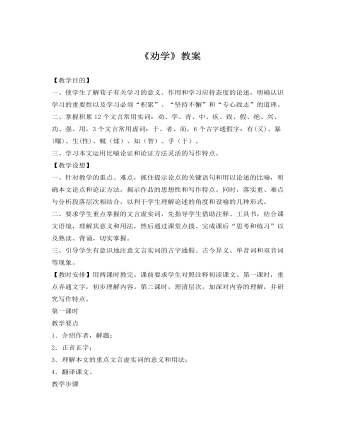
人教版高中语文《劝学》教案
(1)吾尝(曾经)终日而思矣,不如须臾(片刻)之所学也;吾尝肢(踮起脚跟)而望矣,不如登高之博见(看得广)也。(学、思对比,强调了学习的作用;跛望与登高对比,登高的收获大。两例证明利用学习、利用外物的作用。)(2)登高而招(招手),臂非加长也,而见者(看的人)远(远也看得见);顺风而呼(呼喊),声非加疾(快)也,而闻者(听的人)彰(听得更清楚)。(两例证明利用自然条件的作用。)(3)假(借助)舆马者(的人),非利足(快脚)也,而致(达到)千里;假舟楫者,非能水(善游)也,而绝(横渡)江河。(两例证明利用工具的作用。)(4)君子生(性)非异也,善假(利用)于(对)物(外物)也。连用比喻,得出结论:那些有才德的君子,生来本性与普通人没有什么两样(生非异也),只是由于他善于利用学得的知识和本领,善于利用处界条件弥补自身的不足,不断提高自己,所以才成为君子的。
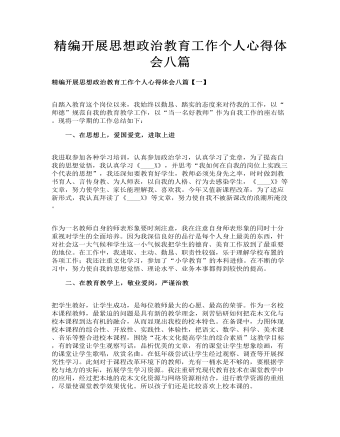
精编开展思想政治教育工作个人心得体会八篇
二、在教育教学上,敬业爱岗,严谨治教 把学生教好,让学生成功,是每位教师最大的心愿、最高的荣誉。作为一名校本课程教师,最紧迫的问题是具有新的教学理念,刻苦钻研如何把花木文化与校本课程到达有机的融合,从而显现出我校的校本特色。在备课中,力图体现校本课程的综合性、开放性、实践性、体验性,把语文、数学、科学、美术课、音乐等整合进校本课程,围绕“花木文化提高学生的综合素质”这教学目标,有的课堂让学生观察写话,品析优美的文章,有的课堂让学生想象绘画,有的课堂让学生歌唱,欣赏名曲。在低年级尝试让学生经过观察、调查等开展探究性学习。此刻对于课程改革环境下的教师,光有一桶水是不够的,要根据学校与地方的实际,拓展学生学习资源。我注重研究现代教育技术在课堂教学中的应用,经过把本地的花木文化资源与网络资源相结合,进行教学资源的重组,尽量使课堂教学效果优化。所以孩子们还是比较喜欢上校本课的。
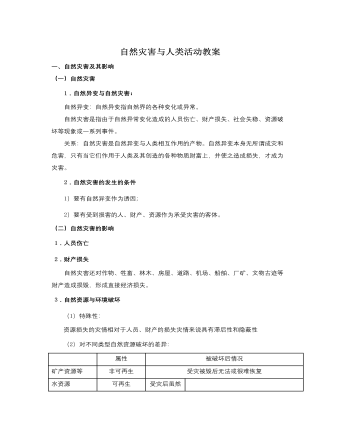
人教版高中地理选修5自然灾害与人类活动教案
(1)类型:常见的农作物病害有:稻瘟病、小麦锈病、棉花枯萎病、烟草炭疽病等。常见的森林病害有:杨树烂皮病、松疱锈病、溶叶病、泡桐丛枝病等。(2)病害发生的原因:A.气候变异等造成的不良环境使得作物对病害抗性降低。B.外来病原体入侵也是病害流行的主要原因。(3)危害:病害使农作物、树木染病从而枯萎甚至死株,导致大面积农田、森林被毁坏。2.虫害和鼠害(1)虫害的常见类型①常见的农作物虫害有:蝗虫、黏虫、水稻螟、棉铃虫等。其中危害最大的是蝗虫。②常见的森林虫害有松材线虫、松毛虫、杨树蛀干害虫、泡桐大袋蛾等。其中松材线虫是世界上最具危险性的森林虫害,被列为国际、国内重大检疫对象。(2)鼠害及危害①重灾区:农田、牧场及森林。②危害:害鼠啃食植株,在地下打洞,危害植物根系,使农业减产,森林草地遭到破坏。(3)虫、鼠害的特点:繁殖快、适应能力强(4)造成虫害和鼠害流行的因素:①适宜繁殖的气候条件、②自然或人为因素造成的天敌减少等,

人教版高中地理选修3第三章第三节中外著名旅游景观欣赏教案
四、法国巴黎塞纳河畔的古城区城市建筑景观往往可以反映一个城市的发展过程,是城市历史的记录。巴黎的塞纳河沿岸景色优美,古老的塞纳河孕育了不可胜数的古迹,1991年巴黎的塞纳河沿岸作为文化遗产,被联合国教科文组织列入《世界遗产名录》。1.发展历史:2000年以前的巴黎只是塞纳河上西岱岛和附近几个小岛上的渔村,后来逐渐扩大,到3世纪开始有了巴黎这个名字。2.巴黎的建筑艺术和名胜古迹图3.35塞纳河风光通过图片,可以看出:塞纳河畔美丽的风景及城市的繁华。图3.36法国首都巴黎塞纳河畔的著名景点——凯旋门、艾菲尔铁塔夜景、卢浮宫外景、巴黎圣母院外景图文结合介绍巴黎塞纳河畔著名景点的位置及有关情况,重点掌握以下内容:①艾菲尔铁塔是巴黎的象征。卢浮宫原为宫殿群建筑,以收藏古典绘画和雕刻闻名。1793年改为国立美术博物馆。巴黎圣母院教堂为一典型的哥特式建筑。
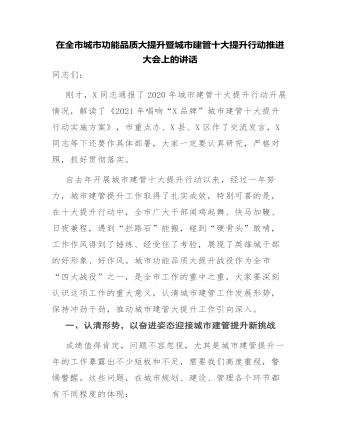
在全市城市功能品质大提升暨城市建管十大提升行动推进大会上的讲话
从规划看,城市规划科学性不够。当前我市在城市规划中还存在着一些不足和需要改进的空间,主要体现在“三个滞后”:一是城市规划设计滞后于城市开发建设,规划有时被建设牵着鼻子走,导致建设不科学不规范无秩序,特别是在高层次大格局谋划X发展上,与大X都市圈周边县市规划衔接不够,以五大功能新城为载体联动周边地区发展规划不够;二是基础设施配套滞后于经济社会发展,地下管网建设滞后,地下空间利用不足,道路和公共基础设施建设缺乏长远性和预见性,造成建设浪费;三是规划设计理念滞后于高品质城市建设需求,城市总体规划、修建性详规、控制性详规等缺乏前瞻性和引领性,对城市风格风貌、色彩色调、天际线岸际线把控不够精细,对城市特质、山水格局彰显不够鲜明。

在全市医保基金飞行检查总结研讨会暨2024年飞行检查动员会上的讲话
同志们,通过飞检,基金监管的形式不容乐观啊。全市各定点医药机构要对照检查发现的问题,引以为戒,举一反三,健全内部医保管理制度,完善岗位职责,自觉规范医疗服务行为,为参保人员提供合理优质的医疗服务,切实履行好规范使用医保基金的主体责任,共同维护医保基金安全。我们医保局在今后的工作中也要进一步加强检查监督力度,加大检查频次,落实医保基金监督管理职责,继续加大飞行检查力度,深入开展打击欺诈骗保专项整治,严肃查处一批大案要案,严厉打击一批重大团伙,坚决曝光一批突出典型,巩固“不敢骗”高压态势。同时,强化大数据监管,构筑全社会监督防线,织密“不能骗”的天罗地网,完善基金总额预算、集采药品结余留用等政策,引导两定机构和医务人员自觉规范服务行为,推动构建“不想骗”的长效机制。规范医保基金使用行为,切实保障医保基金安全稳定运行,守护好百姓的“救命钱”。

新人教版高中英语选修2Unit 1 Science and Scientists-Discovering useful structures教学设计
The grammatical structure of this unit is predicative clause. Like object clause and subject clause, predicative clause is one of Nominal Clauses. The leading words of predicative clauses are that, what, how, what, where, as if, because, etc.The design of teaching activities aims to guide students to perceive the structural features of predicative clauses and think about their ideographic functions. Beyond that, students should be guided to use this grammar in the context apporpriately and flexibly.1. Enable the Ss to master the usage of the predicative clauses in this unit.2. Enable the Ss to use the predicative patterns flexibly.3. Train the Ss to apply some skills by doing the relevant exercises.1.Guide students to perceive the structural features of predicative clauses and think about their ideographic functions.2.Strengthen students' ability of using predicative clauses in context, but also cultivate their ability of text analysis and logical reasoning competence.Step1: Underline all the examples in the reading passage, where noun clauses are used as the predicative. Then state their meaning and functions.1) One theory was that bad air caused the disease.2) Another theory was that cholera was caused by an infection from germs in food or water.3) The truth was that the water from the Broad Street had been infected by waste.Sum up the rules of grammar:1. 以上黑体部分在句中作表语。2. 句1、2、3中的that在从句中不作成分,只起连接作用。 Step2: Review the basic components of predicative clauses1.Definition

新人教版高中英语选修2Unit 1 Science and Scientists-Learning about Language教学设计
Step 7: complete the discourse according to the grammar rules.Cholera used to be one of the most 1.__________ (fear) diseases in the world. In the early 19th century, _2_________ an outbreak of cholera hit Europe, millions of people died. But neither its cause, 3__________ its cure was understood. A British doctor, John Snow, wanted to solve the problem and he knew that cholera would not be controlled _4_________ its cause was found. In general, there were two contradictory theories 5 __________ explained how cholera spread. The first suggested that bad air caused the disease. The second was that cholera was caused by an _6_________(infect) from germs in food or water. John Snow thought that the second theory was correct but he needed proof. So when another outbreak of cholera hit London in 1854, he began to investigate. Later, with all the evidence he _7_________ (gather), John Snow was able to announce that the pump water carried cholera germs. Therefore, he had the handle of the pump _8_________ (remove) so that it couldn't be used. Through his intervention,the disease was stopped in its tracks. What is more, John Snow found that some companies sold water from the River Thames that __9__________________ (pollute) by raw waste. The people who drank this water were much more likely _10_________ (get) cholera than those who drank pure or boiled water. Through John Snow's efforts, the _11_________ (threaten) of cholera around the world saw a substantial increase. Keys: 1.feared 2.when 3. nor 4.unless 5.that/which 6.infection 7.had gathered 8.removed 9.was polluted 10.to get 11. threat

新人教版高中英语选修2Unit 1 Science and Scientists-Reading and thinking教学设计
Step 5: After learning the text, discuss with your peers about the following questions:1.John Snow believed Idea 2 was right. How did he finally prove it?2. Do you think John Snow would have solved this problem without the map?3. Cholera is a 19th century disease. What disease do you think is similar to cholera today?SARS and Covid-19 because they are both deadly and fatally infectious, have an unknown cause and need serious public health care to solve them urgently.keys:1. John Snow finally proved his idea because he found an outbreak that was clearly related to cholera, collected information and was able to tie cases outside the area to the polluted water.2. No. The map helped John Snow organize his ideas. He was able to identify those households that had had many deaths and check their water-drinking habits. He identified those houses that had had no deaths and surveyed their drinking habits. The evidence clearly pointed to the polluted water being the cause.3. SARS and Covid-19 because they are both deadly and fatally infectious, have an unknown cause and need serious public health care to solve them urgently.Step 6: Consolidate what you have learned by filling in the blanks:John Snow was a well-known _1___ in London in the _2__ century. He wanted to find the _3_____ of cholera in order to help people ___4_____ it. In 1854 when a cholera __5__ London, he began to gather information. He ___6__ on a map ___7___ all the dead people had lived and he found that many people who had ___8____ (drink) the dirty water from the __9____ died. So he decided that the polluted water ___10____ cholera. He suggested that the ___11__ of all water supplies should be _12______ and new methods of dealing with ____13___ water be found. Finally, “King Cholera” was __14_____.Keys: 1. doctor 2. 19th 3.cause 4.infected with 5.hit 6.marked 7.where 8.drunk 9.pump 10.carried 11.source 12.examined 13.polluted 14.defeatedHomework: Retell the text after class and preview its language points

新人教版高中英语选修2Unit 1 Science and Scientists-Using langauge教学设计
This happens because the dish soap molecules have a strong negative charge, and the milk molecules have a strong positive charge. Like magnets, these molecules are attracted to each other, and so they appear to move around on the plate, taking the food coloring with them, making it look like the colors are quickly moving to escape from the soap.Listening text:? Judy: Oh, I'm so sorry that you were ill and couldn't come with us on our field trip. How are you feeling now? Better?? Bill: Much better, thanks. But how was it?? Judy: Wonderful! I especially liked an area of the museum called Light Games.it was really cool. They had a hall of mirrors where I could see myself reflected thousands of times!? Bill: A hall of mirrors can be a lot of fun. What else did they have?? Judy: Well, they had an experiment where we looked at a blue screen for a while, and then suddenly we could see tiny bright lights moving around on it. You'll never guess what those bright lights were!? Bill: Come on, tell me!? Judy: They were our own blood cells. For some reason, our eyes play tricks on us when we look at a blue screen, and we can see our own blood cells moving around like little lights! But there was another thing I liked better. I stood in front of a white light, and it cast different shadows of me in every color of the rainbow!? Bill: Oh, I wish I had been there. Tell me more!? Judy: Well, they had another area for sound. They had a giant piano keyboard that you could use your feet to play. But then, instead of playing the sounds of a piano, it played the voices of classical singers! Then they had a giant dish, and when you spoke into it, it reflected the sound back and made it louder. You could use it to speak in a whisper to someone 17 meters away.? Bill: It all sounds so cool. I wish I could have gone with you? Judy: I know, but we can go together this weekend. I'd love to go there again!? Bill: That sounds like a great idea!

新人教版高中英语选修2Unit 2 Bridging Cultures-Discovering useful structures教学设计
The grammar of this unit is designed to review noun clauses. Sentences that use nouns in a sentence are called noun clauses. Nominal clauses can act as subject, object, predicate, appositive and other components in compound sentences. According to the above-mentioned different grammatical functions, nominal clauses are divided into subject clause, object clause, predicate clause and appositive clause. In this unit, we will review the three kinds of nominal clauses. Appositive clauses are not required to be mastered in the optional compulsory stage, so they are not involved.1. Guide the students to judge the compound sentences and determine the composition of the clauses in the sentence.2. Instruct students to try to learn grammar by generalizing grammar rules, controlling written practice, and semi-open oral output.3. Inspire the students to systematize the function and usage of noun clause1.Instruct students to try to learn grammar by generalizing grammar rules, controlling written practice, and semi-open oral output.2.Inspire the students to systematize the function and usage of noun clauseStep1: The teacher ask studetns to find out more nominal clauses from the reading passage and udnerline the nominal clauses.

新人教版高中英语选修2Unit 3 Food and Culture-Discovering useful structures教学设计
The newspaper reported more than 100 people had been killed in the thunderstorm.报纸报道说有一百多人在暴风雨中丧生。(2)before、when、by the time、until、after、once等引导的时间状语从句的谓语是一般过去时,以及by、before后面接过去的时间时,主句动作发生在从句的动作或过去的时间之前且表示被动时,要用过去完成时的被动语态。By the time my brother was 10, he had been sent to Italy.我弟弟10岁前就已经被送到意大利了。Tons of rice had been produced by the end of last month. 到上月底已生产了好几吨大米。(3) It was the first/second/last ... time that ...句中that引导的定语从句中,主语与谓语构成被动关系时,要用过去完成时的被动语态。It was the first time that I had seen the night fact to face in one and a half years. 这是我一年半以来第一次亲眼目睹夜晚的景色。(4)在虚拟语气中,条件句表示与过去事实相反,且主语与谓语构成被动关系时,要用过去完成时的被动语态。If I had been instructed by him earlier, I would have finished the task.如果我早一点得到他的指示,我早就完成这项任务了。If I had hurried, I wouldn't have missed the train.如果我快点的话,我就不会误了火车。If you had been at the party, you would have met him. 如果你去了晚会,你就会见到他的。
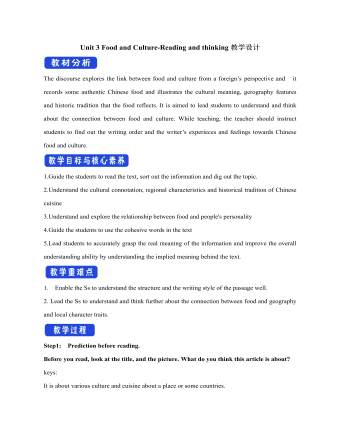
新人教版高中英语选修2Unit 3 Food and Culture-Reading and thinking教学设计
The discourse explores the link between food and culture from a foreign’s perspective and it records some authentic Chinese food and illustrates the cultural meaning, gerography features and historic tradition that the food reflects. It is aimed to lead students to understand and think about the connection between food and culture. While teaching, the teacher should instruct students to find out the writing order and the writer’s experieces and feelings towards Chinese food and culture.1.Guide the students to read the text, sort out the information and dig out the topic.2.Understand the cultural connotation, regional characteristics and historical tradition of Chinese cuisine3.Understand and explore the relationship between food and people's personality4.Guide the students to use the cohesive words in the text5.Lead students to accurately grasp the real meaning of the information and improve the overall understanding ability by understanding the implied meaning behind the text.1. Enable the Ss to understand the structure and the writing style of the passage well.2. Lead the Ss to understand and think further about the connection between food and geography and local character traits.Step1: Prediction before reading. Before you read, look at the title, and the picture. What do you think this article is about?keys:It is about various culture and cuisine about a place or some countries.
